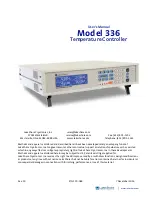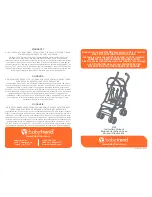
COMMERCIAL IN CONFIDENCE
Page 4
1.2.1 Initialising the Setpoint
The instrument is provided with a safety lock to prevent it from controlling until the setpoint has been
set. This lock is automatically released the first time that the setpoint is changed from the instrument
front panel. If it is required to initialise a new instrument (or after the parameters have been reset), this
lock may be released remotely by performing the following sequence:
tempbyte = (read byte at ModBus address 0125 hex)
tempbyte = tempbyte OR 0x02 {i.e. set bit 1}
(write tempbyte back to ModBus address 0125 hex)
Note that this sequence is only required to unlock the instrument from its reset state - it is not
necessary to perform this sequence each time the setpoint is changed. The other bits within this byte
are used internally and
must not be modified.
1.2.2 Ramp Byte
The
Ramp Byte
holds bits which show what stage of a ramp/soak sequence is currently active:
•
bit 1 set = in ramp phase, display periodically flashing SPr
•
bit 2 set = in soak phase, display periodically flashing Soak
•
bit 3 set = sequence finished, control dormant, display flashes Stop
•
bit 6 set = Holdback LED on front display lit
(9500P only)
note that these bits are mutually exclusive (except the holdback bit), and the flashing display is of lower
priority than the displays recorded by the
Display Byte.
If no bit is set, the instrument is not in a
ramp/soak sequence. If the unit has finished a ramp but no soak time is specified (SOAK= - - ) bit 2
will remain set.
The other bits in the
Ramp Byte
are used internally by the instrument.
The
Ramp Byte
must not be
written to - unpredictable and possibly dangerous instrument behaviour will result.
1.2.3 Display Byte
The
Display Byte
records the message currently being shown on the instrument display, and also
mirrors the state of the SP LED s - note that although these may be read by a remote program, their
values may change rapidly in real time. Due to the time lag in processing communications messages it
may not be possible to exactly mimic the display on a remote screen - particularly for short cycle times.
The hi nibble conveys the following meanings:
•
Bit 7 set = SP2 LED lit
•
Bit 6 set = SP1 LED lit
•
Bit 5 set = add FAIL display to other indications
•
Bit 4 set = SP3 LED lit
(9500 only)
The low nibble of the Display Byte indicates the current alternating message being displayed, thus
after the top 2 bits are masked off
, the following values indicate the display message:
0x01 = PARK / temp
0x02 = -AL- / temp
0x03 = TUNE / temp
0x23 = TUNE / FAIL
0x04 = TUNE / ATSP / temp
0x05 = HAND / heat power ratio
0x25 = HAND / FAIL
0x26 = INPT / FAIL
0x27 = DATA / FAIL
These messages take display precedence over any others. If one of the
Display Byte
messages is
indicated, the remote program must ignore the state of the
Ramp Byte
.






































